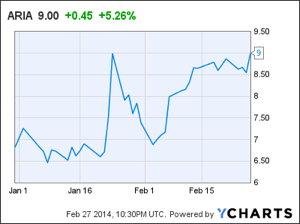Shares of Boston-based Ariad Pharmacueticals, Inc. (ARIA) soared $1.47 to $8.99 per share, up 19.55%, on volume of 134,477,591, more than four-times average daily volume, or more than $1.1 billion worth of common shares changing hands Jan. 24.
The stock has since backed off the speculative spike of Jan 24, but has rallied back to the exact price of $8.99 ($9.02 in after hours) at the close of Thursday’s trading.
What is Going on With ARIA?
Speculation driven by the Daily Mail, which reports that three big-pharma suitors have recently made “friendly approaches” toward Ariad, most assuredly regarding its drug, Ponatinib.
Ponatinib, sold under the label, Iclusig®, is a third-generation drug, prescribed for the treatment of T315I-positive chronic myeloid leukemia (CML).
 Without citing a single source, Daily Mail’s article, title, Three international pharma groups including US giant Eli Lilly make ‘friendly approaches’ for Ariad Pharmaceuticals, the UK daily newspaper claims it was told that three big-pharma names, including Eli Lilly, have expressed interest in Ariad and its franchise drug Iclusig®.
Without citing a single source, Daily Mail’s article, title, Three international pharma groups including US giant Eli Lilly make ‘friendly approaches’ for Ariad Pharmaceuticals, the UK daily newspaper claims it was told that three big-pharma names, including Eli Lilly, have expressed interest in Ariad and its franchise drug Iclusig®.
According to pharmaceutical intelligence publisher, FirstWord Phama, Iclusig is viewed as a serious rival to two other third-generation leukemia drugs, Novartis’s Tasigna and Bristol-Myers Squibb’s Sprycel, in the race for the $4.7 billion-plus-per-year CML market—a market soon to be vacated in 2015 and 2016 by Novartis’ award-winning and blockbusting drug, Glivec.
Glivec’s patent will most likely expire in 2015.
Lending a shred of credence to the Daily Mail’s undocumented source(s) is the timing of the article’s publication; it comes within only seven weeks of Ariad’s news release of Dec. 20, at which time Ariad announced a Food and Drug Administration (FDA) re-approval of a previous FDA suspension of the company’s marketing and distribution of Iclusig®.
Does Lilly Have a Motive and Means to Acquire ARIA?
Motive
As another clue to the authenticity of Daily Mail’s article, is the specific mention of one of the three big-pharma pursuers, Eli Lilly & Company (LLY), one of the pharmaceuticals most impacted by the so-called ‘patent cliff’, a widely-reported and critical issue looming large over the industry.
Of the $290 billion of revenue estimated will be lost due to a slew of patent expirations (‘patent cliff’) anticipated through to 2018, Lilly, alone, projects gradual losses in 2014 of an approximate $6.1 billion portion of its $22.6 billion revenue (2012) from two patents that had expired in December 2013—one patent, for the company’s antidepressant and biggest seller (22% of Q3 revenue), Cymblata, and the other patent, for Evista, a drug to treat osteoporosis.
Considering the impact of Cymblata’s soon-to-be-declining sales volume, Lilly has a strong motive to jump the FDA waiting line and acquire one of the three ready-to-go CML money-makers slated for deployment in a $4.7 billion-plus market. That, despite talk by Lilly chairman, president and CEO John Lechleiter of significant, yet dubious, revenue expected from the launch of its pipeline drugs, empagliflozin, dulaglutide, and ramucirumab in 2014.
Those three Lilly pipeline drugs still await FDA approval; and none of the three is expected to crowd out competitors as a blockbuster drug in the diabetes market, in the case of empagliflozin and dulaglutide, and in the cancer market, in the case of ramucirumab.
Assuming Lilly achieves a one-third share of the CML market by way of the acquisition of Ariad, that’s $1.3 billion of potential yearly revenue for Lilly.
And, according to the Daily Mail article, the whispered tender offer for Ariad may go as high as an all-cash $20-per-share deal, or approximately $3.6 billion, in return for an income stream that could reach more than a billion bucks by 2015.
That’s not a bad deal for either party. Ariad sells out for a double in price from today’s market cap of $1.67 billion, and Lilly acquires a property which reasonably could pay for itself in a few years.
Means
According to Lilly’s annual reports of 2007 through 2012, the company had spent $9.87 billion in cash for acquisitions during the six years. The breakdown by year is as follows:
2012: $199.3 million
2011: 307.8 million
2010: $609.4 million
2009: $0
2008: $6.08 billion
2007: $2.67 billion
As of Sept. 30, 2013, Lilly reported $13.2 billion of Current Assets, of which $4.36 billion is held in Cash or Cash Equivalents. The company also reports a Current Ratio of 1.64 and a Levered Free Cash Flow of $3.55 billion. So, Lilly certainly has the means to acquire Ariad.
Conclusion
Keep an eye on ARIA for higher prices on higher volume, yet, with no news. The story of Lilly’s ‘patent cliff’ and Ariad’s attractive assets have died for now, but we must remember an acquisition of Ariad during a speculative frenzy in the stock works against the suitor. Letting the story fade away aids in the negotiations of price and terms of an Ariad buyout, if, in fact, Eli Lilly is truly considering acquiring Ariad.
If there is substance to the Daily Mail article, ARIA could more than double overnight.
Disclosure: I am long ARIA

0 Comments